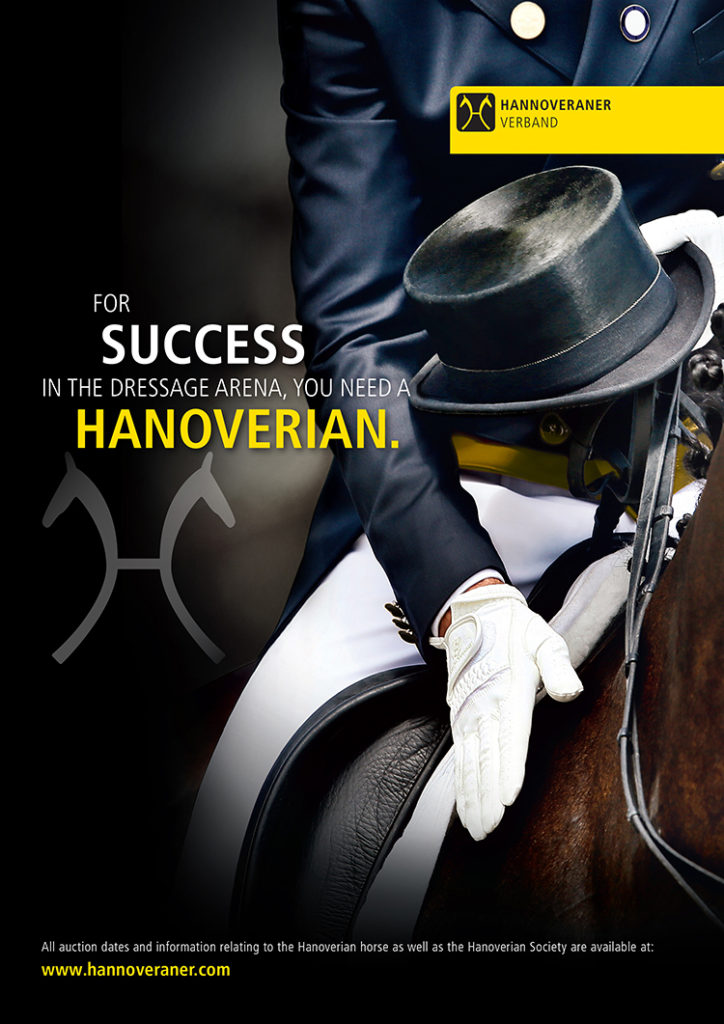Story by Chris Hector and photos by Roz Neave
This story is one of the favourites in our archives, we had written stories with Lisa Wilcox before, but this was the first time we were privileged to see her working with her coach, Ernst Hoyos. 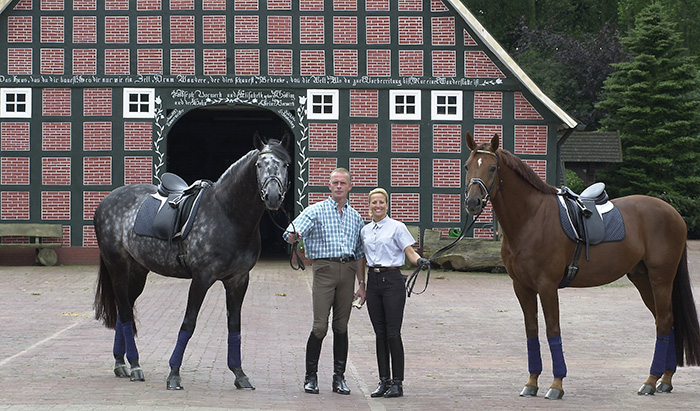
Ernst and Royal Diamond and Lisa and Relevant at the historic Vorwerk Stud back, which now longer exists. Both Royal Diamond and Relevant were stallions by Rubinstein.
Ernst Hoyos is a genius – one of the most exciting rider/trainers in the world of dressage. Here is a man who has emerged from the oldest tradition of classical riding, with something new to say about the art of training dressage horses.
Ernst spent twenty nine years working in a Spanish Riding School that has guarded its principles for 430 years, and he has actually built on that tradition and come up with new ways of training that complement and advance the classical principles.
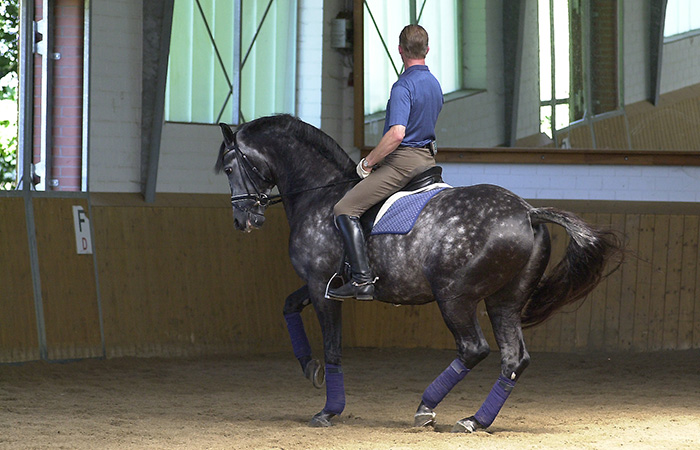 ‘Royal Diamond is beautiful, perfect’, Ernst tell us about his favourite. ‘Your see how well this young stallion is sitting and carrying on his hind legs – that is what we need in piaffe.’
‘Royal Diamond is beautiful, perfect’, Ernst tell us about his favourite. ‘Your see how well this young stallion is sitting and carrying on his hind legs – that is what we need in piaffe.’
There is nothing gimmicky about the way Ernst Hoyos rides but it does take a couple of days to work out what he is doing with his body. For much of the time he seems to be riding in a slightly forward seat, with his arms independent from his body, and with these two amazing feet that are always ALWAYS exactly parallel to the horse’s body no matter what Ernst is doing with the rest of his body – or the horse is doing with its body for that matter.
We first heard about Ernst when we did a story with the American Grand Prix rider, Lisa Wilcox, who works the stallions at the famous Vorwerk Stud in Oldenburg. We knew Ernst had been visiting the Vorwerk Stud as part of a double act with Jo Hinnemann, working with the then resident rider, Martina Hannover.
When Jo became too busy to visit, and Lisa, who replaced Martina as Stud Rider, was looking for a trainer, it was Mrs Vorwerk who suggested that they try to get Ernst Hoyos. It was a fairly major stroke of good fortune for Lisa. Not only did she find a brilliant trainer but also a partner in her personal life, for Ernst has moved from Vienna to the little town of Cappeln and now instead of working with Ernst once a fortnight, the pair work Mrs Vorwerk’s stallions every day, except when Ernst is travelling south to work with his other star pupil, Ulla Salzgeber.
story continues below the advertisement
The Vorwerk Stud is the perfect place to see Ernst work since here is a collection of stallions ranging from babies to Grand Prix horses but all selected by a stud master in Gudula Vorwerk who seems to have inherited her father’s legendary eye for a horse. There have been a few changes since our visit twelve months ago, and one of the most dramatic has been the baby Raoul, who last time had just emerged from his 100 day test and found one corner of the school just so scary he could not go into it. Now the Rohdiamant son is so grown up and handsome, and while he is still a bit looky he has faith in Lisa.
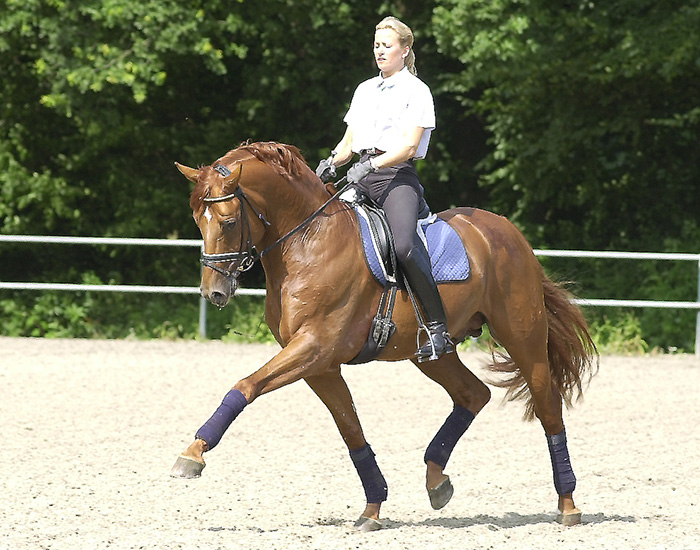
Ernst comments: “In a five year old horse, we see balance – very good balance – and so the picture speaks for itself”
Ernst comments: “This is showing the gymnastic work in the very beginning, showing that the rider is keying the horse into the aids. Notice the outside rein again…outside rein, inside bend focussing on getting the horse to respond to the aids in a gymnastic process”
“Last time you were here, I was a new rider for him after his performance test, but now he knows he can depend on me.”
Raoul qualified for the Bundeschampionate this year, in the 5 year old class but sadly wasn’t able to go since Lisa had a date with Relevant at the WEG in Jerez at the same time. Still there is always next year…
story continues below the advertisement
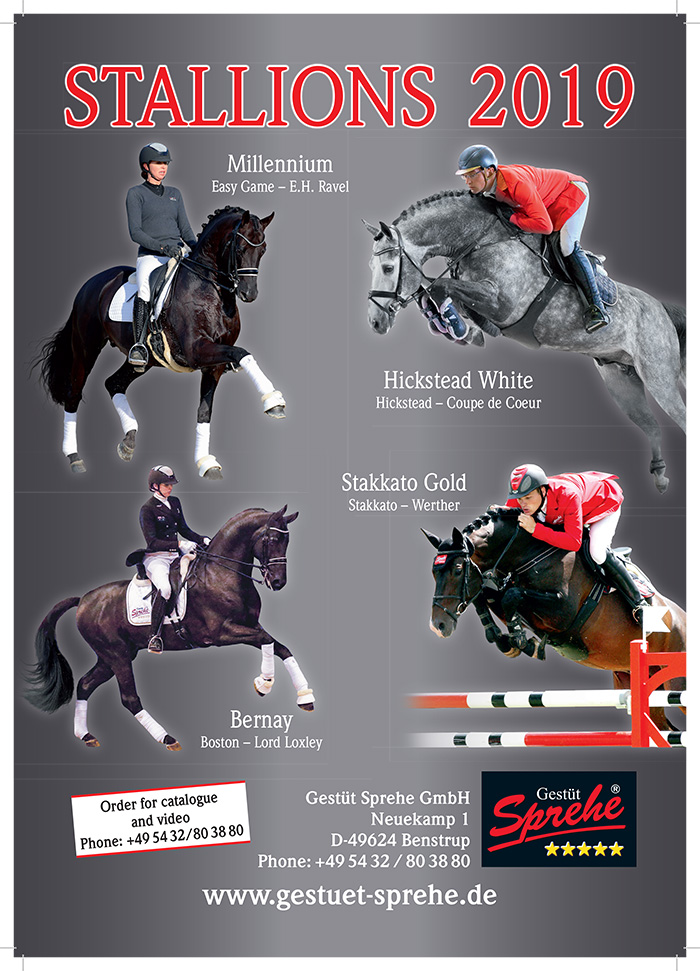
Lisa is riding Raoul very deep and round, and a couple of inches behind the vertical. Which is a bit of a puzzle since we believed that the Spanish Riding School was the last enclave of the credo that behind the vertical is behind the bit and a mortal sin. Not so Ernst tells me later:
“At the Spanish Riding School they have to work their horses through just like everyone else, just like we do – and then when you get into an arena to present them, then they go on the vertical. You have to work behind the vertical, and you do it in the Spanish School.”
Lisa has her own way of putting it: “If you don’t put the nose behind the vertical, then you are just riding concrete. You are stiffening something up. If I sit in one position for a week, then I can’t imagine how I am going to feel when I get up – and it is the same with the horse, you have to keep changing their position. When I’m riding like this I’m loosening the horse in the throat latch and getting him to soften, and you can only do that when you have them over the back and laterally gymnasticised, and soft in to the hand. Most important, we are not just talking about the front – we are ALWAYS gymnasticising the whole horse”
It is noticeable that when Lisa and Ernst work the horses deep and round, it is more round than deep, and they don’t work them as low as Sjef Janssen does with his extremely deep position. According to Ernst:
“I am looking for the middle. Further down is for me is too far, and not far enough is too high. The task is to find the middle for each horse you ride. If you ride the horse too far down then shoulder is too strongly blocked and they can’t be as expressive in front. If you are too far up then you have lost ‘over the back’ automatically, then you don’t have the hind legs any more. If you have the middle, then the horse’s shoulders can still reach – and muscles from the horse are not stressed by extreme up-riding, or by extreme deepriding. This is the healthier middle way, by being in the centre, it is much better for the horse than being extremely high or low. Our young horses they start with a little trot but they are reaching. The shoulders are moving bigger and bigger.”
story continues below the advertisement
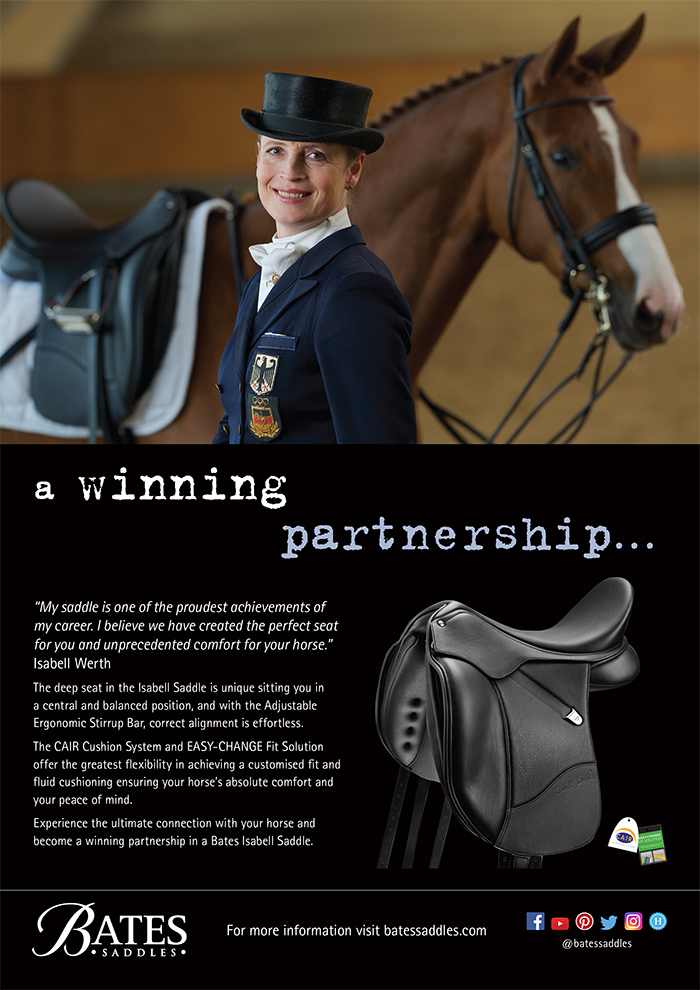
The other interesting thing about the way Lisa is working Raoul is the way she is really flexing him to the inside and using very small circles with a lot of bend.
Later, Ernst explains the thinking behind the exercise:
“The volte is one of the most important movements you can ride. It is teaching the horse to bend in his ribcage, within his body, and then to maintain a rhythm – in the future this movement will become a half pass. We are working on control over the balance of the horse so that it is learning to maintain a rhythm.”
Even with the young horses you start with quite a small circle?
“It must not be done with strength, it must be done with the balance of the horse, then the horse is clear in his head and when he is balancing, he is carrying himself, but if someone is doing it with strength – pushing and pulling – then it is not productive for the horse. If the horse is learning it in his own balance, then that is correct. In a volte, the horses begin to collect themselves automatically. It comes from them. We’re not asking for it, it is through this movement, where we are maintaining the balance and helping them, but they are learning a lower level of collection by themselves. Through these exercises the horse strengthens itself in the direction of collection.”
How do we go from using this direct inside rein to get the horse to sit on the outside rein?
“Especially in the volte you need an extreme outside rein. I ride the volte with the outside rein, that is how I maintain the shoulder on the circle. Then you can bend with the inside rein and let him go, and the horse stays there. I guide the horse on the circle with the outside rein not with the inside rein. That’s what you think because you look and see an overbending of the horse, but always it is the outside rein that is controlling the shoulder of the horse. The inside rein is loosening the horse, but it isn’t the rein that is guiding him on the circle. You can let the inside rein go, and the horse will stay on the circle. The inside rein is bending – gymnasticising, loosening, suppling – but it is not responsible for keeping the horse on the circle.”
“The outside rein is for me like the wall on the track, or the edge of the autobahn, the inside shoulder I am working on to free up, to make bigger. The outside rein is the border and it maintains the horse – the inside is loosening and freeing the horse up. When you come to a half pass for instance, the inside shoulder should be getting bigger and bigger and bigger, and the outside shoulder and rein guide the horse across on the line. You can change the amount of bend if you like, but the outside rein and shoulder keep the movement where it ought to be.”
story continues below the advertisement
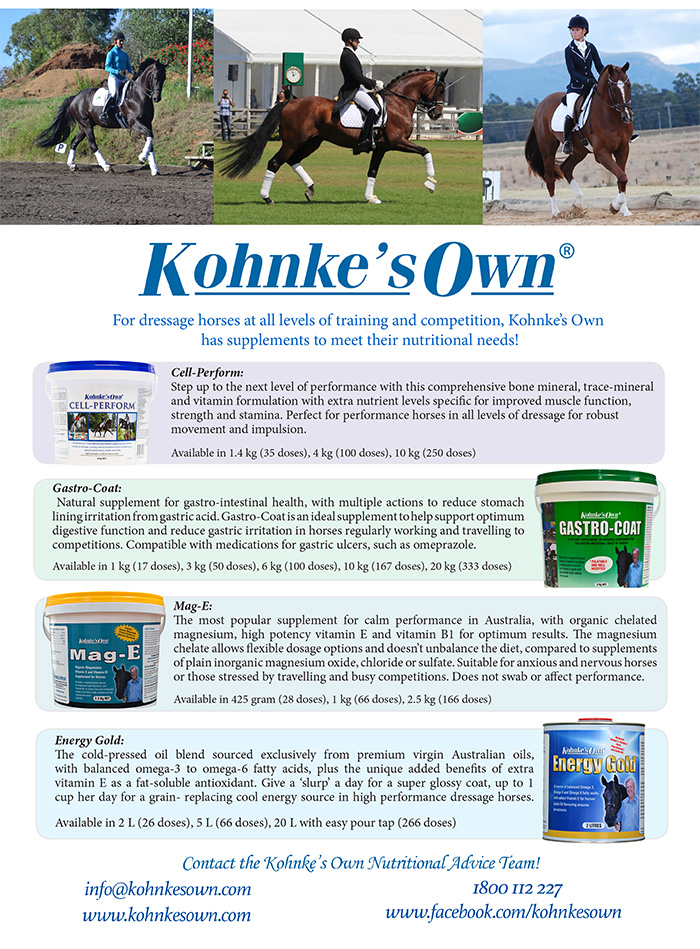
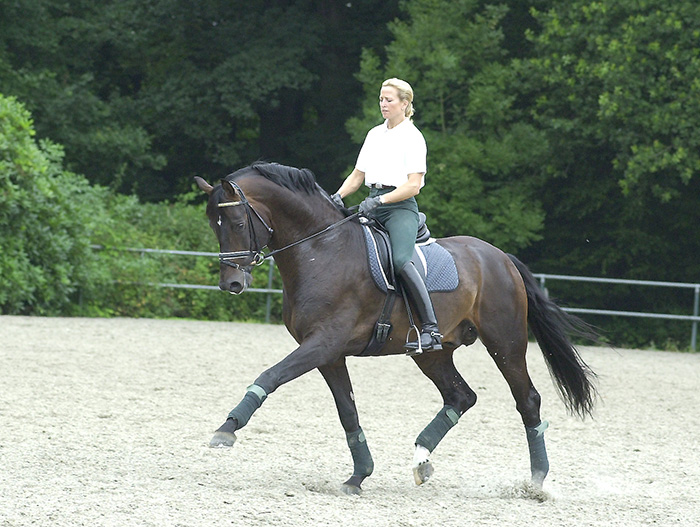
Looking at this extended trot, basically you see the German Training Scale. The horse is very relaxed and smooth, there is no tension, he is in the right frame, he has rhythm, he is straight, all these things in one. Look at the muscles, no tension.
At the end of her session with Raoul, Lisa lets him really breeze out in the walk but she explains that this is a tricky balance to achieve:
“He has a super walk, I just want him a bit more steady in the frame. When you ask for a big walk at a competition, often the young horse will start looking around because they don’t recognize the walk as a movement. You give him a long rein and he thinks ‘oh it’s all over I can look around’ They’ve got to learn it’s a movement.”
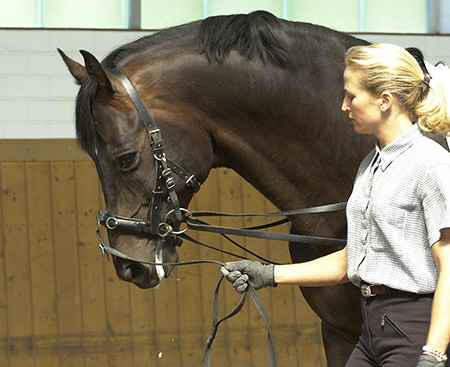
The next horse to work is Danny Wilde and with his rider in Spain, he too will not be able to take his place in the six year old class at the Bundeschampionate, Lisa is starting to prepare him with some in-hand work for the Nürnberger BurgPokal, the German national competition for horses under 9 years old at Prix St Georges level. Ernst Hoyos is recognized in Germany as a maestro of the in hand work, which is not surprising given his almost three decades in Vienna. He has even designed his own cavesson with a clip on, clip off bit attachment. It is a proper cavesson, with a shaped leather covered metal piece for the nose, which makes it so much easier to get a correct bend from the horse’s head.
“We always attach the lunge line to the cavesson when we lunge,” explains Lisa, “if we want them to chew and accept the bit, then we can’t be hard on it in any way. How often do you see people lunging with the rein attached to the ring of the bit, and the whole bit ends up coming through the horse’s mouth when they spook or avoid bending.”
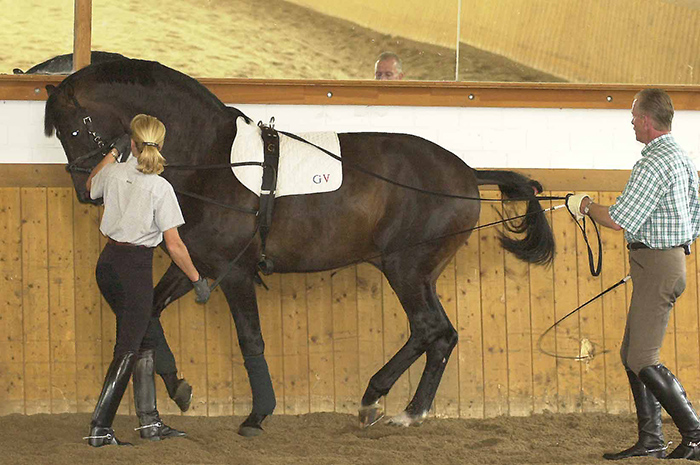
A very correct aspect of the piaffe, a perfect picture of the piaffe showing that the horse is lower behind than in front, he is sitting, and it shows the potential this horse has for the higher levels. For a six-year-old this is more than perfect.
But this gear is not for lunging it is for the in hand work, with Lisa at the front with a rein, and Ernst working behind with one rein and two whips, with Danny’s tail neatly coiled in a rubber band so that Ernst can touch the horse where-ever he wants (‘and it doesn’t pull the tail out’ says Lisa). In the beginning, Ernst has the outside rein attached to the cavesson, but when Danny decides not to listen, it is transferred to the ring of the snaffle. There are a lot of things happening with all those reins and whips, and Danny hasn’t been worked in hand for three months, but you can see the rhythm starting to build.
story continues below the advertisement
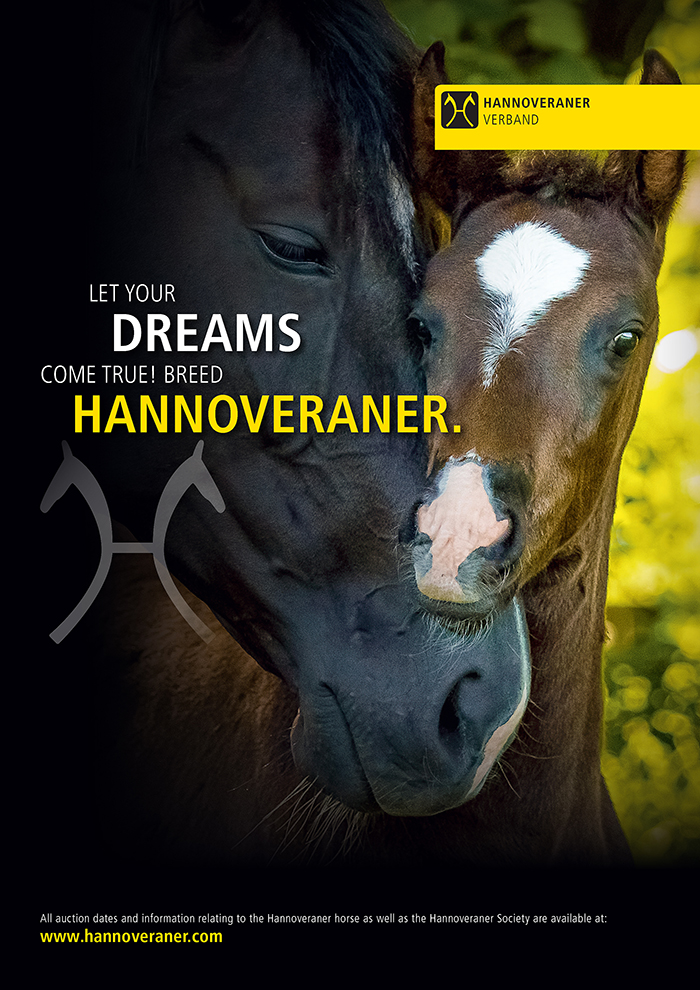
Ernst warns that in hand work should be left to those with the skill and experience to handle it:
“There are very few people who have the talent to do in hand work. You do have to study it; you do have to get a feeling for it and for the horses because it is steering the horse without touching him. You’ve got to see when the horse is cramping up. Riding, I feel that but in hand you’ve got to see it and back off, let him go forward.
A lot of riders don’t have enough of that feeling. When I look at the horse I don’t just see the back leg. In my peripheral vision I can see if the horse is too deep, or I see that the left hind and the right fore leg aren’t even, I have to control the legs, the front, the frame – and tell the person in front, bring the horse back a pace, he is too forward in the piaffe bring him back. Not many people can see all these things at once, and if you can’t see those things, then it is better not to work on the hand.”
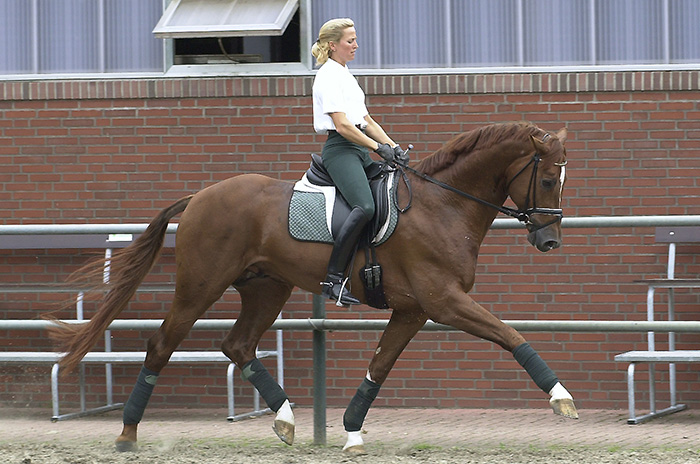
Another of the Vorwerk stallions, Feramo, by Fidermark
I asked Ernst, how essential hand work was in his program?
“Piaffe is the most difficult level of collection, and there is a much greater chance of the horse learning piaffe if it is taught in the hand. This is because he is working without a rider on his back, he only has to balance himself – and that increases the chance that he is going to understand and accomplish piaffe. The chance is higher than when he has to balance a rider at the same time.”
Do you think the horse ever becomes dependent on the work in hand – so the horse is great when the trainer is there, but when he goes in for the test, the piaffe gets lost…
“No because the horses do this until they are good at doing it, then no more. Royal Diamond and Relevant, you would not need to do this work in hand. Anyway, as the horse learns the work in hand, then the rider gets on and it is a combination of work in hand, and under saddle. To help the horse along, we start on the hand so we can key into his body this movement, this balance act, then you put the rider on, just to see how much he understood and how much he is able to balance himself. The rider has to be very quiet to help the horse also. Then at one point you stop the in hand work and only do it under saddle and it develops fabulously.”
story continues below the advertisement
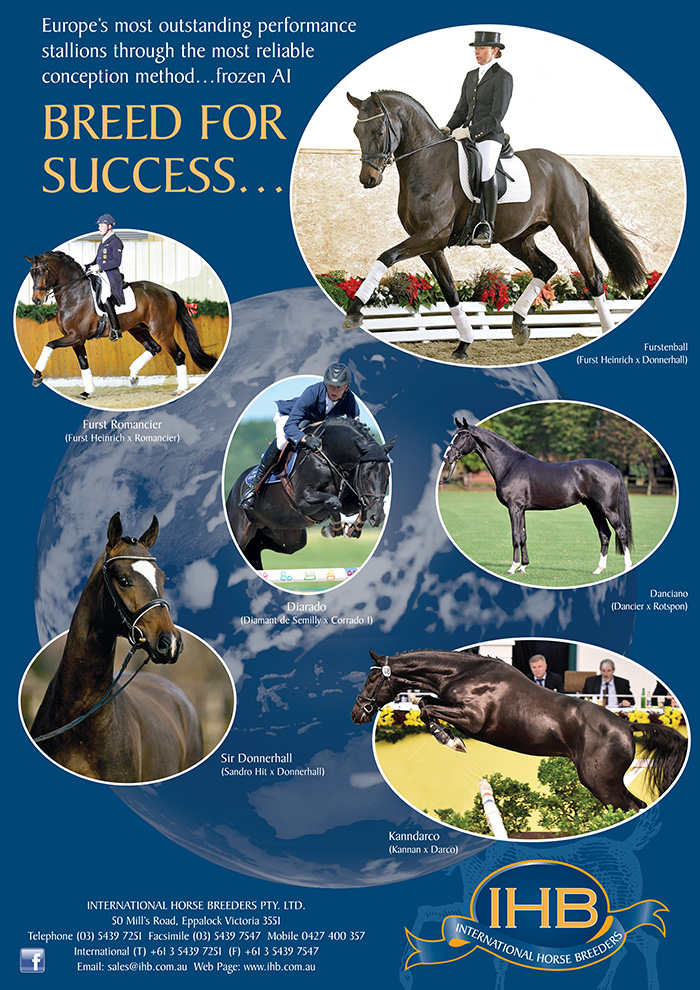
Now there are two horses in the school, Ernst riding the eight year old Royal Diamond (there was once some discussion about whether Roy was black or grey, now there can be no doubt with the magnificent black dapples on his shining grey skin.) Lisa is riding another exciting youngster, the four year old Feramo, a son of the Westfalien stallion star, Fidermark.
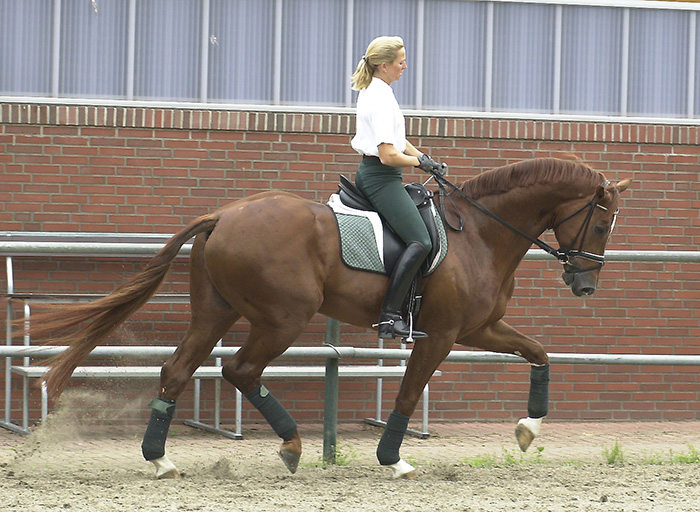
Feramo is going through a growth spurt, which has put his hind end a bit higher than his front end, but the chestnut is so big and so soft and so expansive – and when he gets a little spook, wow- he is not just soft and sweet but so scopey and exciting.
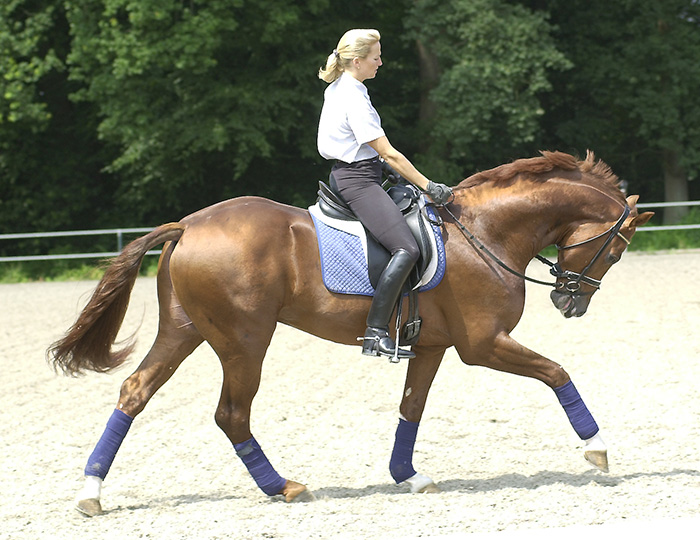
“He is still a baby,” says Lisa, “he tends to push his under-neck out when he spooks or stresses, and I have to work on getting him over the back. We are really excited about this stallion because in our area the breeding is saturated with Rubinstein, Rohdiamant and Royal Diamond, and we need something else.”
It certainly looks as if Mrs Vorwerk has found that ‘something else’ yet again!
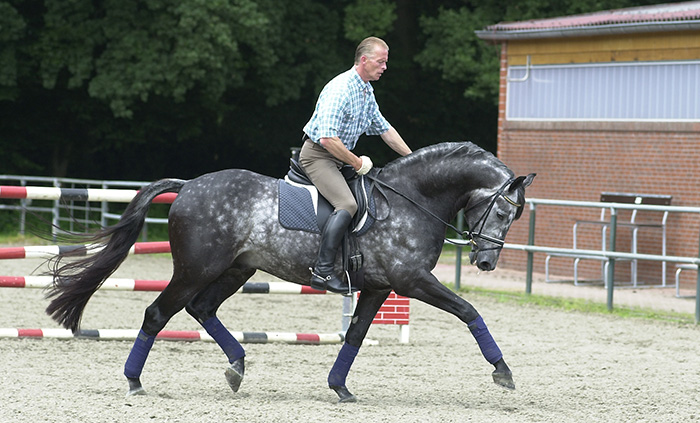
Ernst: Here the horse is being ridden like a young horse, with the rider not interfering letting his back come up. This is a phase in rising trot with the upper body a little forward to get the horse to relax and work up over the back.
Ernst’s position in the saddle is very distinctive and it takes a little while to work out what he is doing at first. Almost a forward seat position, and with lots of work in rising trot, to loosen the horse and get him over the back, even half pass is sometimes done in rising trot, and when he does sit, it is in a very light seat. Ernst explains later that he believes if you can work on the seat of the rider, you can automatically improve the work of the horse. I ask him if this is something he learnt in the Spanish Riding School?
“Half and half… in the Spanish School they are very disciplined where the seat is concerned and how it works with the horse. My half is that I am for the horse. Yes, I am for the rider, but I am more for the horse and I want to see the horse understand, and that the rider does not disturb the horse, the horse is able to work – and the communication is the seat. I personally am very strict about the seat because I want to see that the horse is able to understand.”
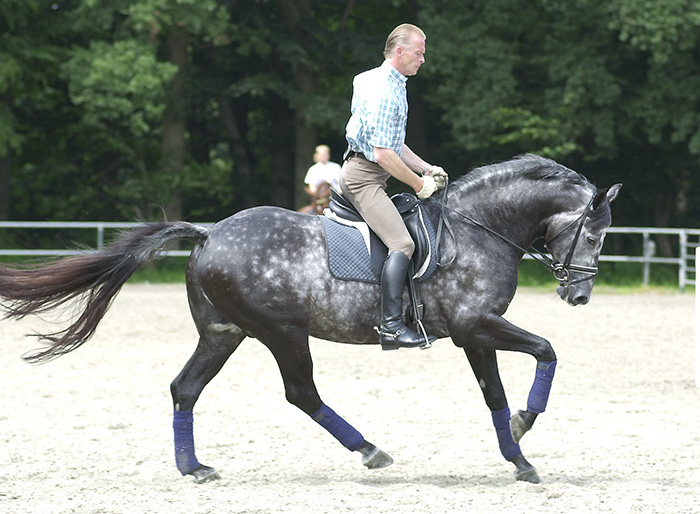
You were saying how you simplify it for the young horse – go forward, come back. It is not with the leg, it is not with the spur, but with the angle of the body more than anything else?
“I compare it with kids in the school, you start to count with your fingers, you overexaggerate and you help them. With the horses I use my body to communicate with them and to show them with the weight. When they get older it gets finer, they learn the balance, and I will use just a little bit of weight that you can’t see, but the horse will react, that is the refinement of riding. Our goal should always be in dressage that one does not see what is happening, that should always stay our rule.”
“I developed my way of riding a little bit myself. From horse to horse it is different. When I ride young horses I have to consider my weight. If I am riding a horse for Lisa I try to apply my body at her weight. Especially for something like piaffe or passage, I will use a lighter seat because if I rode the horse in a full seat and then Lisa got on the horse it would wait for that weight, it wouldn’t react so sensitively to her.”
Roy gets a bit tangled going into the piaffe, but Ernst just sits there, quietly clucking, and holding the straightness, channelling the energy, and sure enough it starts to come. We are in the presence of one of the world’s great masters of collection.
Ernst Hoyos began his equestrian career at the age of four riding Icelandic horses in Austria. His father was the first to import Icelandic horses to his part of Austria, and now the family has a very good Icelandic stud, and to this day Ernst’s brothers still breed, train and ride Icelandic horses professionally.
But the family also bred Thoroughbreds for the racetrack, and the ones that weren’t fast enough, Ernst rode in eventing competition.
At the age of seventeen he entered the Spanish Riding School as a cadet – and stayed there for 29 years.
Ernst felt that he had accomplished everything he could in the Spanish Riding School, and during his last ten years with them, he was already working with competition horses and riders. That became more and more interesting for him, and so finally he decided to work full time with competition dressage horses.
Did it require a great change of technique to go from the way of riding of the Spanish school to the world of competition dressage?
“They place more importance on certain things in the Spanish Riding School while competition dressage places emphasis on other things, but the riding in itself is the same. For instance in the Spanish School they do not put so much emphasis on the walk as we do in competition dressage, they don’t put so much value on getting the biggest trot they can get – especially in the Quadrille, they have to reduce the trot so you can get it all done evenly with twelve riders. Where in competition dressage we want to get every gait as big as we can get it. The horse’s elasticity, the relaxation, the horse being through, that’s the same. Making the horse look easy to ride, that is what they want in the Spanish School, and that is what we also want.”
I would have thought that with the Spanish Riding School training so many riders every year, in such a thorough way. that the School would have produced many trainers who went on to be successful working with competition riders, but this has not been the case?
“The riders get too involved in the Spanish School and they don’t take time to become involved in dressage sport. They don’t give themselves the education of the entire picture, they become too involved in what the Spanish Riding School is doing, so they end up reducing their own abilities because they are not thinking in the wider spectrum. They get a little bit too narrow-minded. You are in the Spanish Riding School and that is a big thing, then when you come out it is not the same.”
What was it like to leave the School after 29 years, was that like leaving a monastery?
“Because I had spent ten years coming to Germany and helping Ulla Salzgeber and Jo Hinnemann, coming to the Vorwerk Stud and working with Martina Hannover, then when I left the Spanish Riding School it was not such a big change … ”
This article first appeared in the November 2002 issue of THM.

